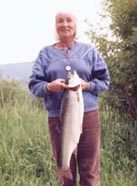Is there
really a "Kamloops Trout"? A trout that is distinct and different
from other Rainbow Trout? Surprisingly the answer is both yes and
no. Since this seems a contradictory answer, it will require a quick
look into the history of the Kamloops Trout to discover why.
Fort
Kamloops was established in 1812. Soon, the early residents had time
to try some angling in the local lakes. Virtually all the smaller
upland lakes were barren and only the larger mainstream lakes had
resident fish.
Over
the next 80 years, stories began to be whispered about the trout being
caught in the southern interior of British Columbia. These stories
grew and told about a trout that had more stamina and strength than
other Rainbow Trout and grew to a very large size. It also looked
somewhat different than the familiar Rainbows.

Finally
in 1892, samples of this fish were sent to a Dr. Jordan at Stanford
University. This was before the days of refrigeration and rapid transit
so I expect the fish arrived somewhat ripe. However, Dr. Jordan went
about the smelly task of identifying the fish and found that indeed
the fish were physically different from the Rainbow Trout scientifically
named Salmo gairdneri at that time (they are now named Oncorhynchus
mykiss).
These
western Canadian fish averaged 150 to 154 rows of scales. That was
significantly higher than the scale rows of Salmo gairdneri. It also
had fewer gill rakers (those finger-like projections on the inside
of the gills which filter out debris), fewer rays or bones in the
dorsal and anal fins, and fewer branchiostegal rays (those indented
lines under each of the jaws).
Proportionally,
the head of these trout was wider and longer than Salmo gairdneri.
The maxillary process and the length of the fins were also longer.
The underside fins were a brighter orange, more like a Brook Trout,
and the camouflage spots were more distinct than on other Rainbow
Trout.
Armed
with these physical differences and the stories of their stamina,
strength, and size, Dr. Jordan believed he had a new species of trout.
He gave it the scientific name Salmo kamloops or Kamloops Trout. With
an official name, the legend of the Kamloops Trout had begun.
Over
the next 30 years, a couple of small fish hatcheries were established,
some of the smaller lakes were stocked with Kamloops Trout and a commercial
fishery was even started on the larger lakes in the area. Lakes such
as Kamloops, Kootenay and Shuswap Lakes were producing fish that averaged
about ten pounds. And there were stories of fish from 30 to 55 pounds,
such as the big one from Jewel Lake. Fly fishers started to fish the
newly stocked but smaller lakes. Kamloops Trout of 15 to 18 pounds
were being caught from lakes after the third year of stocking. Salmo
kamloops was becoming known to wealthy anglers around the world.
Then
in 1931 a Dr. Mottley began to study the Kamloops Trout. He discovered
that the differences in Salmo Gairdneri and Salmo Kamloops were due
to environmental conditions rather than genetic differences. He had
found that the spawning streams in south central British Columbia
were about 9 degrees Fahrenheit cooler than most spawning streams
around the world.
He conducted
an experiment in which Kamloops Trout eggs from the same fish were
hatched and raised in two different environments. One set of eggs
were hatched and raised at the normal stream temperatures around Kamloops
and the second set were hatched and raised in waters 9 degrees warmer
than would normally be expected in the local spawning streams. Those
fish raised in the warmer water did not develop the extra scale rows
and other physical differences of Salmo Kamloops. He had raised both
types of fish from the same batch of eggs and thus proven that Salmo
Gairdneri and Salmo Kamloops were indeed the same fish. The differences
were environmental rather than genetic.
In subsequent
work, Dr. Mottley also found a few other quirks of the Kamloops Trout
that are of interest to the angler. The cool spring time and hot summers
played a part in the development of these fish. Water temperatures
remained cool, like alpine streams, during the critical phases of
development, which are the egg, alevin and fry. This cool water was
responsible for the physical differences in the fish. During the hot
summer the water warmed sufficiently to provide vast quantities of
food for the growing trout. This helped to explain the strength, stamina
and size differences. Mottley even found that the physical characteristics
of the Kamloops Trout changed with the elevation of the lake in which
they were raised. Also, attempts to stock Kamloops Trout in other
locations have all met with failure unless the environmental conditions
are virtually the same as in southern British Columbia.
Shortly
after Dr. Mottleys work was confirmed the scientific community removed
Salmo Kamloops from its official registry of fish species. Officially
the Kamloops Trout ceased to exist. And yet those fish with that extra
strength and stamina, those extra rows of scales, the fin and camouflage
spot differences and larger size are still in the lakes of south central
British Columbia. So in answer to our original question, "YES" there
is a Kamloops Trout that is distinct and different from other Rainbow
Trout in terms of its fighting ability and physical characteristics.
But "NO" it is not genetically different from the more familiar Rainbow
Trout. It is a product of the local environment and cannot be exported.
As a
final note to avoid any misunderstanding for those who may be coming
to British Columbia to fish Kamloops Trout for the first time. These
trout no longer average 10 pounds. Kamloops Trout in the five to 10
pound range are still caught but over the years most of our lakes
have been over stocked at one time or another. This has significantly
reduced the amount of available food in the lakes and thus reduced
the average size and fast growth rates of the Kamloops Trout. In addition,
some lakes that have historically been prime producers of large Kamloops
Trout are now classified as "Put-And-Take" lakes and are still being
over stocked.
Today
you can expect about one fish in a hundred to be five pounds or over
(depending on lake, etc) and another 23% of your catch should be in
the two to five pound range. A two pound fish will average about 18
inches in length.
Good
angling and enjoy your stay.




